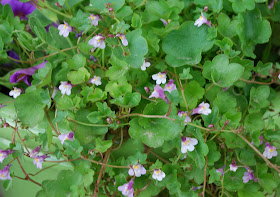Ground covers can include a number of unexpected plants, including flowering gems that spread and spread, plants with variegated foliage, shade plants, sun loving plants, and tight mats of impenetrable green.
Pulmonaria, the lungwort Raspberry Splash. One of the very first to bloom, with these spotted leaves that persist all year after the brightly colored flowers fade. These reliably set seed and spread themselves around under the trees, providing interest wherever they are.
Lamium, another early bloomer, also called by the depressing name of Dead Nettle. These come in many varieties of pink, purple and white, with variegated foliage that spreads rapidly in shady situations, greeting the spring with cheerful spikes of color.
The chalk-white iberis Candytuft. This is nearly evergreen for me. After the flowers fade in the spring, the dark green foliage fills in nicely between the roses.
Convallaria majalis, the Lily of the Valley, scents the deep shade garden under the trees in late spring. These form impenetrable ropy-rooted colonies that crowd everything else out, but all is forgiven when they bloom. They do not tolerate sun well at all.
Two intertwined low-hugging plants, the blue-blooming veronica repens--the creeping speedwell, and the pink-edged crawling sedum Tricolor. Sedum loves the sun, while I have had good luck with the creeping speedwell in sun and shade.
I included Lady's Mantle, alchemilla, because it does reseed generously, forming large round-leaved plants throughout the shade garden. The blooms are uninspiring yellow green, but the green mounds of leaves are welcome under the trees.
The everbearing strawberries have escaped from the raised beds and are invading my filtered shade borders, to the point that they are becoming rather a pest as a ground cover. In spite of the fact that they do produce strawberries. They seem to think they are border flowers and do much better, in fact, than they do in the raised beds.
Periwinkle will grow anywhere there is shade and water, so watch out. This plant has spread and spread, filling in under the trees, providing this dependable blue color in swaths each spring.
Saponaria, the wandering soapwort. I have given up on this plant, letting it appear, grow, drape across logs and rocks in this amazing way, bloom, and then vanish, only to reappear somewhere else, with a slight variation in the pink color.
Anacyclus of the Aster family. This is Silver Kisses, the little white daisy petals lined with red, complete with ferny foliage. The plant itself doesn't live long, but if encouraged it will reseed. It is very nice at the front of the border.
I planted one plant of the herb Sweet Woodruff, galium odoratum, and now it is growing all around my iris and peonies and tulips in the morning sun. It blooms these tiny white crosses in spring, and the crisp yellow green-foliage romps happily all summer.
I love this plant. Cymbalaria, the Ivy-Leaved Toadflax or Kenilworth Ivy. Five round-lobed leaves with these delicate purple-lavender blossoms. Don't be fooled, these plants are quite hardy and put up with a lot. This is one of the best for filling in the soil in pots, since the leaves and flowers hang over the edge so nicely. They also spread here and there, never unwanted or out of control
Of course, white alyssum does wonders for the front of the border, along with verbena, one of my personal favorites for pots. Here, a species-type purple verbena pops up among the sweet alyssum.
One of the worst of the unwanted ground covers--Creeping Jenny. This chartreuse variety is Golden Moneywort "Aurea." Don't plant it unless you want everything surrounded, invaded, and crowded out by chartreuse.














Baccarat, Baccarat, & More - Urban Dictionary
ReplyDeleteBaccarat is 1xbet korean a variation on the popular American card game. Originally invented in Germany in 샌즈카지노 the 1700s, this game is a variation on the popular 바카라 사이트 American card game